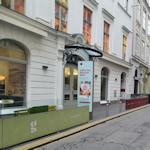
Not all images and perceptions of Jewish men and women are antisemitic. But clichés still have consequences. The Jewish Museum explores 100 Misunderstandings about and among Jews in a thought-provoking exhibition.
- Themed areas invite reflection and debate
- Indirectly encourages self-criticism and self-awareness
- Exhibition laced with humour and art, too
- Has led to “robust” discussions locally
- All texts in English & German
- Runs Nov 30, 2022 – Jun 4, 2023
- See also:
Clichés & Misconceptions

(Exhibition view; photo © Ouriel Morgensztern)
Most examinations of prevailing Jewish stereotypes tend to take place in the context of antisemitism.
A less-explored aspect is those many misconceptions that aren’t antisemitic per se, but can still have a range of consequences for society…from the banal to the insidious.
For example, a Jewish population might be thought of as a migrant community entirely independent of its actual heritage (and even in areas where the “local” population is itself a product of migration). And we know where being seen as immigrants can lead in today’s world.
100 Misunderstandings about and among Jews digs deeper into some of these (inaccurate) perceptions to create a rather impactful exhibition, with guaranteed raised eyebrows for the viewer.
At its core, you have a stream of statements about Jews (itself often used as a loaded term!) across seven chapters.
Each statement comes with a short text and some item or piece of media that might illustrate the misconception, question it, or provoke you to give the matter some more thought.
The goal is not to offer a point-by-point academic rebuttal, but to use humour, art, and other devices to get a response from the viewer.
And that response is at the heart of the exhibition experience.
First, you soon discover (with some embarrassment) your own ignorance and misconceptions on certain topics: biases you may never have been aware of.
Examples include perceptions of Mossad, female soldiers in Israel or the true meaning or prevalence of “an eye for an eye.”

(Pure Holy Land Air, Product of Luftgescheft; photo by Sebastian Gansrigler and © Jüdisches Museum Wien)
Second, you realise (also with some embarrassment) how little critical thought you may have applied to your consumption of media, which allows stereotypes to sneak into the subconscious.
You might never have questioned the image of the bullish overbearing Jewish mother perpetually fed to us on film and TV. Yet Marie-Louise von Motesiczky’s portrait reveals the intimate vulnerability of her own mother.
Third, some statements require a more refined analysis, encouraging you to see the grey areas between the black and white extremes produced by our desire to oversimplify and tendency to polarise.
In that context, the exhibition throws up questions which might seem simple on the surface, but hide considerable nuance.
What clothes should you wear when visiting the Anne Frank House? Can a Jew enjoy an opera written by the antisemitic Richard Wagner? Is it acceptable for a Holocaust survivor to dance at Auschwitz?
Inevitably, such an approach is not without its controversy, and the exhibition has had a mixed reception locally.
The exhibition also recognises how misunderstandings arise from within the Jewish community itself.
A perceived obligation to internal solidarity, for example, can encourage a false sense of homogeneity and neglect the diversity within any particular community.
Nor are Jewish museums themselves immune from contributing to misunderstandings and misconceptions.
Most of us probably think the star of David, for example, is an exclusively Jewish symbol. The exhibition has a historical oven bearing the symbol, which the Jewish Museum put on display (twice before) given the strong Jewish connection.
Turns out the star was actually a hexagram intended to ward against fire.
In a wider sense, 100 Misunderstandings about and among Jews becomes a reminder that so much of what we assume we know is driven by historical coincidence, media framing, political expediency, false narratives and similar.
Consider it a wake-up call to think more critically. A call expressed without judgement and with a wink that carries an underlying seriousness.
Dates, tickets & tips
Explore those misconceptions between November 30th, 2022 and June 4th, 2023. Any entrance ticket for the Jewish museum allows access to the special exhibition.
On a similar theme, a nearby location that addresses historical misconceptions about Austria is the House of Austrian History. This relatively new museum tackles the country’s post-WWI era, some of which can come as a surprise to visitors only familiar with Habsburgs and WWII.
How to get there
See the Jewish Museum overview article for travel tips: you want the main Dorotheergasse location.
Address: Dorotheergasse 11, 1010 Vienna